

Vacuum arc. A vacuum arc can arise when the surfaces of metal electrodes in contact with a good vacuum begin to emit electrons either through heating (thermionic emission) or via an electric field that is sufficient to cause field electron emission.

Once initiated, a vacuum arc can persist since the freed particles gain kinetic energy from the electric field, heating the metal surfaces through high speed particle collisions. This process can create an incandescent cathode spot which frees more particles, thereby sustaining the arc. At sufficiently high currents an incandescent anode spot may also be formed. Electrical discharge in vacuum is important for certain types of vacuum tubes and for high voltage vacuum switches. The thermionic vacuum arc (TVA) is a new type of plasma source, which generates a pure metal and ceramic vapour plasma containing ions with a directed energy. Streamer discharge. Streamer discharges into the air from the high voltage terminal of a large Tesla coil.
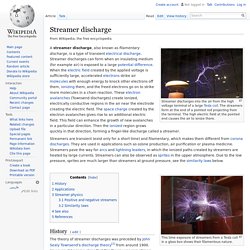
The streamers form at the end of a pointed rod projecting from the terminal. The high electric field at the pointed end causes the air to ionize there. A streamer discharge, also known as filamentary discharge, is a type of transient electrical discharge. Streamer discharges can form when an insulating medium (for example air) is exposed to a large potential difference. When the electric field created by the applied voltage is sufficiently large, accelerated electrons strike air molecules with enough energy to knock other electrons off them, ionizing them, and the freed electrons go on to strike more molecules in a chain reaction.
This time exposure of streamers from a Tesla coil in a glass box shows their filamentous nature. History[edit] The theory of streamer discharges was preceded by John Sealy Townsend's discharge theory[1] from around 1900. Applications[edit] Streamer physics[edit] ratio. Electric discharge in gases. Electric discharge in gases occurs when electric current flows through a gaseous medium due to ionisation of the gas.
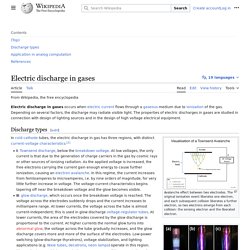
Depending on several factors, the discharge may radiate visible light. The properties of electric discharges in gases are studied in connection with design of lighting sources and in the design of high voltage electrical equipment. Discharge types[edit] Avalanche effect between two electrodes. The original ionisation event liberates one electron, and each subsequent collision liberates a further electron, so two electrons emerge from each collision: the ionising electron and the liberated electron.
Electrostatic discharge. Electrostatic discharge (ESD) is the sudden flow of electricity between two electrically charged objects caused by contact, an electrical short, or dielectric breakdown.
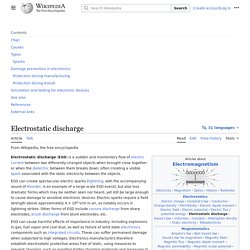
A buildup of static electricity can be caused by tribocharging or by electrostatic induction. The ESD occurs when differently-charged objects are brought close together or when the dielectric between them breaks down, often creating a visible spark. ESD can create spectacular electric sparks (lightning, with the accompanying sound of thunder, is a large-scale ESD event), but also less dramatic forms which may be neither seen nor heard, yet still be large enough to cause damage to sensitive electronic devices. Electric sparks require a field strength above approximately 40 kV/cm in air, as notably occurs in lightning strikes. Dielectric barrier discharge. Dielectric-barrier discharge (DBD) is the electrical discharge between two electrodes separated by an insulating dielectric barrier.
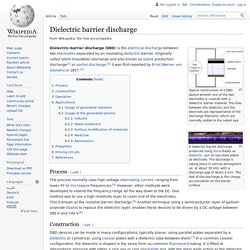
Originally called silent (inaudible) discharge and also known as ozone production discharge[1] or partial discharge,[2] it was first reported by Ernst Werner von Siemens in 1857.[3] On right, the schematic diagram shows a typical construction of a DBD wherein one of the two electrodes is covered with a dielectric barrier material. The lines between the dielectric and the electrode are representative of the discharge filaments, which are normally visible to the naked eye. Below this, the photograph shows an atmospheric DBD discharge occurring in between two steel electrode plates, each covered with a dielectric (mica) sheet. The filaments are columns of conducting plasma, and the foot of each filament is representative of the surface accumulated charge. Brush discharge. A large brush discharge from the top of a Tesla coil.
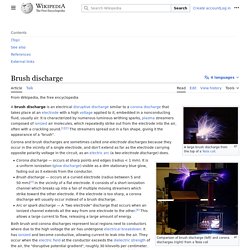
Comparison of brush discharge (left) and corona discharges (right) from a Tesla coil Closeup of a Tesla coil brush discharge, showing its filamentous nature Corona and brush discharges are sometimes called one-electrode discharges because they occur in the vicinity of a single electrode, and don't extend as far as the other electrode, as in an electric arc (a two-electrode discharge). Corona discharge — occurs at sharp points and edges (radius < 1 mm).
It is a uniform ionization (glow discharge) visible as a dim stationary blue glow, fading out as it extends from the conductor.Brush discharge — occurs at a curved electrode (radius between 5 and 50 mm)[3] in the vicinity of a flat electrode. Both brush and corona discharges represent regions next to conductors where the air has ionized and become conductive, allowing current to leak into the air. See also[edit] References[edit] External links[edit] Electric discharge. Voltage versus current characteristics for neon gas at 1 Torr pressure between flat electrodes spaced 50 cm.
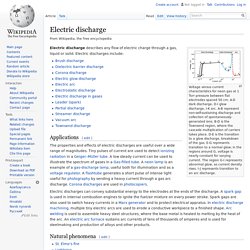
DC%20Discharges%20III. Intro gas discharges.
Electrical Discharges. How the spark, glow and arc work Contents Introduction: fundamental processesThe Voltage-Current CharacteristicsThe Spark: Breakdown: electron avalanche, Townsend discharge, Paschen's Law, Geiger-Müller tubeThe Glow Discharge: cathode phenomena, positive column, laser pumping, similitude, sputteringThe Arc Discharge: cathode phenomena, low- and high-pressure plasma, negative resistance, carbon arc in airApplications of Arcs: welding, lamps, rectifiers, switching, protection, fuses.References Introduction.
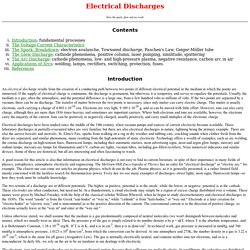
Minimum Ignition Curves. Static Electricity.